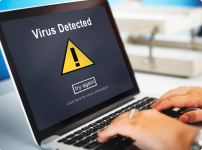Your computer is humming along, tabs open, work flowing—until suddenly, it freezes. Pop-ups flood the screen. Files disappear. Panic sets in. No, it’s not a tech tantrum. Your device might have just caught something nasty—a computer virus. But this isn’t the 90s anymore, and viruses aren’t just annoying—they can be catastrophic.
Gone are the days when computer viruses just slowed down your machine or pulled a prank. Today, malicious code can drain your bank account, steal your identity, or even hold your data hostage (hello, ransomware These aren’t just bugs in the system. They’re weapons in the digital battlefield, targeting users, businesses, and governments alike. And here’s the kicker—you don’t need to click on a shady link anymore. Sometimes, all it takes is visiting the wrong website or plugging in an infected USB.
One of the scariest things about computer viruses is how quietly they move. Like digital ninjas, they:
Imagine your computer as a body. When infected, it runs slow, behaves oddly, and sometimes refuses to work.
Here’s what a virus can do once it’s inside:
 Install trusted antivirus software
Install trusted antivirus software
 Don’t open suspicious links or email attachments
Don’t open suspicious links or email attachments
 Keep your software and OS updated
Keep your software and OS updated
 Avoid sketchy websites and pirated files
Avoid sketchy websites and pirated files
 Use strong, unique passwords (not your pet's name
Use strong, unique passwords (not your pet's name  )
)
Think of these habits as your digital immune system—keeping you safe in the wild web world.
As AI evolves, so do cyber threats. Modern viruses are now AI-powered, encrypted, and adaptive, making them harder to detect and destroy. On the bright side, cybersecurity tools are getting smarter too. Machine learning algorithms can now predict and prevent attacks before they happen. The war is on, and it’s a tech race like no other.
Computer viruses aren’t going anywhere. They’re evolving with us, learning our habits, exploiting our blind spots. But with awareness, caution, and the right tools, we can outsmart them. So the next time you download a “free movie” or open a weird email from a prince in Nigeria—pause, think, and protect your digital life.
Because in today’s world, cyber hygiene is self-defense.
Modern-Day Malware: Beyond the Obvious
Gone are the days when computer viruses just slowed down your machine or pulled a prank. Today, malicious code can drain your bank account, steal your identity, or even hold your data hostage (hello, ransomware These aren’t just bugs in the system. They’re weapons in the digital battlefield, targeting users, businesses, and governments alike. And here’s the kicker—you don’t need to click on a shady link anymore. Sometimes, all it takes is visiting the wrong website or plugging in an infected USB.
Silent Invaders: You May Already Be Infected
One of the scariest things about computer viruses is how quietly they move. Like digital ninjas, they:
- Operate in the background
- Log your keystrokes
- Access sensitive data
- Open doors for more malware
What Happens When a Virus Hits?
Imagine your computer as a body. When infected, it runs slow, behaves oddly, and sometimes refuses to work.
Here’s what a virus can do once it’s inside:
- Corrupt or delete files

- Steal sensitive data like passwords and banking info

- Crash your operating system

- Hijack your device for larger cyberattacks (botnets)

How to Stay One Step Ahead
The best way to fight a virus? Don’t let it in.Think of these habits as your digital immune system—keeping you safe in the wild web world.
AI, Hackers, and the Future of Digital Defense
As AI evolves, so do cyber threats. Modern viruses are now AI-powered, encrypted, and adaptive, making them harder to detect and destroy. On the bright side, cybersecurity tools are getting smarter too. Machine learning algorithms can now predict and prevent attacks before they happen. The war is on, and it’s a tech race like no other.
Final Thoughts: Awareness Is the Best Antivirus
Computer viruses aren’t going anywhere. They’re evolving with us, learning our habits, exploiting our blind spots. But with awareness, caution, and the right tools, we can outsmart them. So the next time you download a “free movie” or open a weird email from a prince in Nigeria—pause, think, and protect your digital life.
Because in today’s world, cyber hygiene is self-defense.

